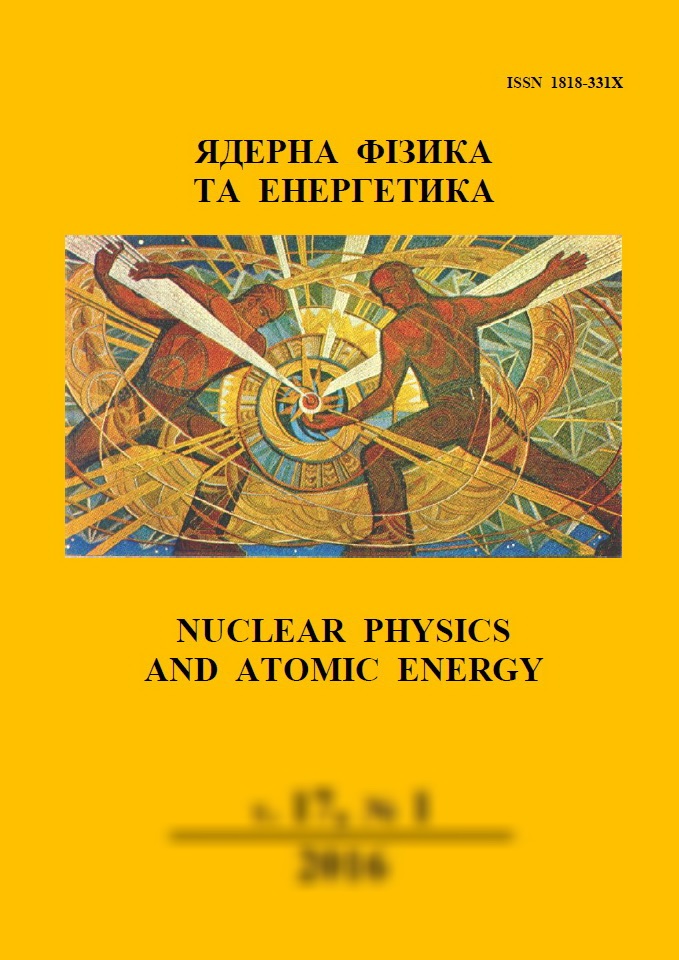 |
ßäåðíà ô³çèêà òà åíåðãåòèêà
Nuclear Physics and Atomic Energy
ISSN:
1818-331X (Print), 2074-0565 (Online)
Publisher:
Institute for Nuclear Research of the National Academy of Sciences of Ukraine
Languages:
Ukrainian, English
Periodicity:
4 times per year
Open access peer reviewed journal
|
Nucl. Phys. At. Energy 2021, volume 22, issue 1, pages 85-92.
Section: Radiobiology and Radioecology.
Received: 11.11.2020; Accepted: 02.04.2021; Published online: 19.06.2021.
 Full text (ua)
Full text (ua)
https://doi.org/10.15407/jnpae2021.01.085
Changes in the content of carotenoids and flavonoids in medicinal raw material of Digitalis purpurea, Polemonium caeruleum, and Aerva lanata, cultivated in vitro under the chronic action of ionizing radiation
S. V. Litvinov*, L. G. Lioshyna, O. V. Bulko, K. V. Lystvan, S. A. Pchelovska
Institute of Ñell Biology and Genetic Engineering, National Academy of Sciences of Ukraine, Kyiv, Ukraine
*Corresponding author. E-mail address:
slitvinov83@gmail.com
Abstract:
Chronic low-dose γ-irradiation of Digitalis purpurea and Aerva lanata plants in vitro have led to an increase in the content of carotenoids and flavonoids in the leaves at the beginning of the post-radiation period. In the following, the content of pigments and flavonoids decreased in comparison to the control samples. For Polemonium caeruleum such changes had been not observed. The qualitative composition of the secondary metabolites has not been changed, but the ratio of the individual components of the extract varied within a small range. Ri-transformants of Digitalis purpurea have been shown smaller changes in response to irradiation. We assume that the observed effects are the manifestation of the adaptive response of plants to oxidative stress caused by chronic low-dose irradiation.
Keywords:
chronic irradiation, low doses of radiation, pigments, flavonoids, Digitalis purpurea, Polemonium caeruleum, Aerva lanata.
References:
1. D.M. Grodzinsky. Adaptive Strategy of Physiological Processes of Plants (Kyiv: Naukova Dumka, 2013) 303 p. (Rus)
2. A.M. Kuzin. Stimulating Effect of Ionizing Radiation on Biological Processes (Moskva: Atomizdat, 1977) 275 p. (Rus)
3. D.M. Grodzinsky. Plant Radiobiology (Kyiv: Naukova Dumka, 1989) 384 p. (Rus)
Book
4. I. Boubriak et al. Long term effects of Ñhernobyl contamination on DNA repair function and plant resistance to biotic and abiotic stress factors. Cytology and Genetics 50(6) 381.
https://doi.org/10.3103/S0095452716060049
5. L. Lioshina et al. X-ray effects on stress response of the Ri-transformants in vitro Digitalis purpurea L. Radiation & Applications 2(1) 1.
https://doi.org/10.21175/RadJ.2017.01.001
6. N.M. Rashidov, N.K. Kutsokon. Target and non-target radiobiological reactions – their threshold and non-threshold effects. Problemy Bezpeky Atomnykh Elektrostantsiy i Chornobylya (Problems of Nuclear Power Plants' Safety and of Chornobyl) 3(2) (2005) 42. (Rus)
http://mntc.smn.com.ua/downloads/2005_032/c42.pdf
7. S.V. Litvinov. Effects of chronic exposure of seeds and seedlings of Arabidopsis thaliana by low doses of γ-radiation on plant growth and development. Yaderna Fizyka ta Energetyka (Nucl. Phys. At. Energy) 15(4) (2014) 406. (Rus)
https://jnpae.kinr.kyiv.ua/15.4/Articles_PDF/jnpae-2014-15-0406-Litvinov.pdf
8. Biological mechanisms of radiation actions at low doses. A white paper to guide the Scientific Committee's future programme of work. (New York: UNSCEAR, 2012) 45 p.
https://www.unscear.org/docs/reports/Biological_mechanisms_WP_12-57831.pdf
9. Low doses of ionizing radiation: biological effects and regulatory control. Contributed papers. IAEA-TECDOC-976 (Vienna: IAEA, 1997) 710 p.
https://www-pub.iaea.org/MTCD/Publications/PDF/te_976_prn.pdf
10. L.G. Lioshina, O.V. Bulko. Plant regeneration from hairy roots and calluses of periwinkle Vinca minor L. and foxglove purple Digitalis purpurea L. Cytology and Genetics 48(5) (2014) 302.
https://doi.org/10.3103/S009545271405003X
11. M. Butnariu, C.Z. Coradini. Evaluation of Biologically Active Compounds from Calendula officinalis Flowers using Spectrophotometry. Chemistry Central Journal 6 (2012) 35.
https://doi.org/10.1186/1752-153X-6-35
12. M. Tikkanen et al. Regulation of the photosynthetic apparatus under fluctuating growth light. Philosophical Transactions of the Royal Society B. Biological Series 367 (2012) 3486.
https://doi.org/10.1098/rstb.2012.0067
13. G. Agatia et al. Flavonoids as antioxidants in plants: Location and functional significance. Plant Science 196 (2012) 67.
https://doi.org/10.1016/j.plantsci.2012.07.014
14. A. Fini et al. Stress-induced flavonoid biosynthesis and the antioxidant machinery of plants. Plant Signaling & Behavior 6(5) (2011) 709.
https://doi.org/10.4161/psb.6.5.15069
15. V.P. Bulgakov et al. Application of Agrobacterium Rol genes in plant biotechnology: a natural phenomenon of secondary metabolism regulation. Genetic Transformation. Maria Alvarez (ed.) (IntechOpen, 2011).
https://doi.org/10.5772/24200
